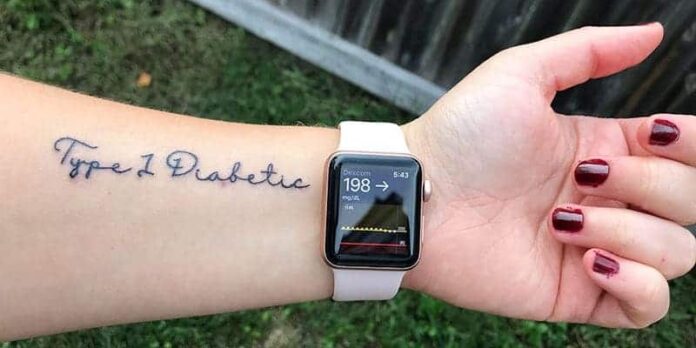If you read outdated books on living with diabetes, those of us living with this disease shouldn’t even walk around our house barefoot let alone get a tattoo!
But these days, people with all types of diabetes are “living dangerously” by walking barefoot in their own homes and even getting tattoos that are about diabetes.
You can absolutely get a tattoo if you live with diabetes, but there are still a few things you need to consider before popping into your local tattoo parlor.
In this post, I will cover everything you need to know about diabetes and tattoos, what it looks like when things go wrong — and if doctors and EMTs even trust those diabetes-related medical alert tattoos!
Your A1c and overall risk of infection in a new tattoo
The reason people with diabetes are traditionally discouraged from getting a tattoo is that higher blood sugars levels impair your body’s ability to heal properly, and can easily lead to an infection.
People with type 1 and type 2 diabetes have a significantly increased risk of developing any type of infection, according to Diabetes Care Journals. And those with type 1 diabetes have an even higher risk than those with type 2.
Just like an ignored blister in a person with consistently high blood sugar levels can lead to an infection severe enough to become gangrene and risk losing their toe or entire foot, a tattoo on a person with high blood sugar levels could become severely infected, too.
People with diabetes should consider the following details regarding HbA1c levels before getting a tattoo:
A1c under 8.0: “If you want a tattoo and your last couple of A1c tests were under 8%, and you don’t have any neurological problems, heart disease, or kidney damage, getting a tattoo should be safe as long as you keep it clean and keep your blood glucose levels in range. Your body shouldn’t have any trouble healing the tattoo as long as they take good care of it.”
A1c over 9.0: “However, if your last few A1cs were 9% or over, or if you’re experiencing any neuropathy, circulation, or kidney problems, getting a tattoo could put your life in danger. When your tattoo can’t heal quickly, it becomes a playground for bacteria and can lead to infection and eventually gangrene.”
If your A1c is above 9 percent, that doesn’t mean you can’t ever get a tattoo safely, it simply means you may have just found a new motivation for improving your overall diabetes management and getting your blood sugars into a healthier overall range before getting a tattoo.
“It was definitely on my mind,” says Leanne Matthews. She’s lived with type 1 diabetes since age 7, over 16 years, and has three tattoos. “But my blood sugars are in tight control and my A1c is under 7, so I wasn’t that concerned.”
Leanne’s first tattoo was purposefully small, so she could see how her body reacted to getting one. In addition to diabetes, she knew some people’s skin reacts poorly to tattoos, including rare sensitivities to the colored ink.
“I got my first tattoo in Italy, so, yeah maybe that was a little sketchy when I look back at the condition of the tattoo parlor,” recalls Leanne. “Maybe not the smartest decision!”
As a health coach, Leanne definitely agrees with the standard advice that you should wait until your blood sugars are in a healthier range before getting a tattoo.
“And if you have any history of infections, you really don’t want to risk getting a tattoo if your A1c is high.”
*Read Diabetes Strong’s Guide to Lowering Your A1c!
What the healthy healing process of a tattoo should look like
Nobody’s tattoo looks all that pretty in the first week of healing, so it’s important to understand what the normal healing process will be like. Authority Tattoo explains:
- Stage One (Days 1-6): “Oozing, swelling, and redness that gets better gradually over each day. Scabbing begins to form over the area.”
- Stage Two (Days 7-14): “Itching and flaking begin, and this continues until all layers of dead skin and scabbing have fallen off.”
- Stage Three (Days 15-30): “Tattoo looks fully healed but may look slightly cloudy for a few weeks. Deeper layers of skin are still repairing, so continue to look after your tattoo.”
How to properly care for your new tattoo
Caring for your new tattoo is actually very straight-forward, and critical when it comes to preventing infection, and for ensuring it looks beautiful when it’s finally healed! Your tattoo artist should give you clear instructions on a piece of paper, but here are the basics from:
- Gently wash your tattoo every morning and night with lukewarm water and antibacterial soap. Pat it dry with a clean towel or paper towel.
- Rinse it with water (at least) any time it comes in contact with dirt or excessive sweat, or other dirty environments.
- Apply a recommended “lotion” at least twice a day. Vaseline or cocoa butter are usually recommended. Avoid anything with added scents or colors–these could contribute to an infection.
“Every tattoo I’ve had they tell me something different about how to care for it,” Leanne said. “But the point, no matter what, is about keeping it clean.”
Being a regular gym-goer, Leanne was concerned about her own sweat drenching her new tattoos and germs from everyone else all over the gym equipment. Her solution for this was simple: wash it immediately after every workout.
“With my largest tattoo on my thigh,” adds Leanne, “I definitely paid extra attention to keeping it clean and taking care of it, because it’s a bigger area that could potentially get infected.”
The most common causes of infections in tattoos
Preventing an infection in your new tattoo while it heals is actually pretty straightforward….right? Just keep it clean! But there’s a nice long list of things that can easily introduce an infection–many of which you might not even think of, like the type of body lotion you use every day!
- High blood sugars in those with diabetes
- Unsanitary tattooing environment
- Unsanitary tattooing equipment
- Ineffective cleaning
- Rewrapping the tattoo (which traps germs and sweat in the area)
- Picking and peeling your scabs (scabs help your skin heal!)
- Scratching your tattoo
- Bathing in dirty water…take showers instead!
- Letting others touch your new tattoo
- Using too much lotion — apply only as directed, not constantly
- Generally unhealthy lifestyle habits around nutrition, alcohol, sleep, etc.
Keep it clean and dry. Don’t scratch or pick at it. Use Vaseline or another recommended tattoo moisturizer. And when you’re showing it off to your new friends, tell ‘em to keep their hands off it!
Signs of an infection in a new tattoo
“Straight after getting a new tattoo,” explains Authority Tattoo, “the area is essentially just a large and open wound that is very vulnerable to germs and bacteria until the skin is able to protect itself by creating a formation of scabs over the wound before finally regenerating a permanent outer protective layer of skin over the area.”
Authority Tattoo cautions that just because your tattoo may be small doesn’t mean an infection isn’t incredibly real and crucial to take care of quickly.
“If left untreated, some infections can lead to blood poisoning, shock, and even eventually organ failure and death.”
The most common signs of infection include:
- Spotty rash: sometimes red, sometimes white
- Extreme redness 5 days after getting the tattoo
- Extreme itching (healthy scabs will itch a little, apply more Vaseline!)
- Feels hot to the touch
- Swelling 5 days after getting the tattoo
- Oozing scabs (healthy scabbing is normal, oozing scabs are not)
- Blistering
- Excessive oozing, pus, especially associated with pimple-like bumps
- Foul odor
- Red streaking on the skin around the tattoo (also known as blood poisoning)
- Swollen lymph nodes (a sign your body is trying to fight infection)
- Fever and tiredness
If you think your tattoo may be infected, visit your doctor or local urgent care immediately. As people with diabetes, we need to take infections very seriously and get them treated very quickly. Even with an A1c under 8 percent, our bodies are still inevitably more prone to infection than a non-diabetic, and those infections can worsen more quickly, too.
To see pictures of infection symptoms, visit Authority Tattoo. *Warning: very graphic!
Consider the location of your tattoo
As if diabetes doesn’t rear its ugly head enough in every part of your life, it’s also going to try to tell you where on your body can get a tattoo.
Areas with impaired circulation
It’s easy to forget that even if your A1c has been under 8 percent for decades, areas of your body inevitably have impaired blood circulation compared to others.
Our hands, feet, ankles, and even our shins are the most common “tattooable” areas on your body that can easily have poor blood circulation. That means these areas are less ideal for a tattoo simply because they may not heal as quickly or are at a greater risk of infection during the healing process. If you already have been diagnosed with neuropathy, and you’re choosing to get a tattoo despite suggestions that you shouldn’t, it would be wise to avoid any of those affected areas.
Common sites for your injections, infusion sites & CGM sensors
Do you often inject insulin in the back of your arm? Is your favorite spot for an insulin pump infusion site on your abdomen or thigh?
Think carefully about where you most frequently inject insulin, where you place infusion sites for your pump, and where you insert sensors for your continuous glucose monitor (CGM), because all of those sites will inevitably have more scar tissue.
Those areas will also be unavailable after you get a tattoo placed there because constantly piercing it with sharp objects and injecting it with insulin will inevitably destroy your beautiful tattoo!
Leanne admits she didn’t follow this advice too closely.
“I picked the spot on my body where I wanted it. I’m not gonna let diabetes tell me where I can get a tattoo, especially since my blood sugars are healthy. If I want to get a tattoo in the middle of my thigh, then that’s where I’m getting it,” she says firmly. “And I would just not use that area for injections anymore.”
It’s tedious–definitely–that diabetes gets to have a say in where on your body you get a tattoo but it’s also critical and in your best interest to think carefully before accidentally getting a tattoo in your favorite injection area!
When it’s time to get your first tattoo…
If there was ever a time to be a little bit obsessed with your blood sugar management, the days before you get your tattoo and the few weeks that follow when it’s working to heal are worthy of diabetes management obsession.
It’s critical to remember that just because your tattoo is healed on the outside of your skin within that first week, there is still a great deal of healing that takes place in the tissue below your skin. The more your blood sugars stay in a healthy range during the weeks after getting a tattoo, the better it will heal, the more quickly it will heal, and the less likely you’ll experience a healing-related complication or infection.
Do EMTs notice “medical alert” diabetes tattoos?
It’s so common these days to see “type 1 diabetes medic alert” tattoos on Instagram, but before you swap your medic alert jewelry for a tattoo, it’s important to find out if EMTs and healthcare professionals in emergency rooms even notice or look for a medic alert tattoo on a patient.
The answer is that EMTs will not necessarily look for a medic alert tattoo.
“A friend of mine is an EMT,” explains Leanne. “She said they can’t assume you have diabetes just because of a tattoo because it might be there to represent your child’s diabetes.”
However, they’re still likely to notice it, and then consider checking your blood sugar and eventually learning that you have diabetes. So it’s not completely lost, it’s just not an exact and equal replacement for medical alert jewelry.
Is a tattoo the right choice for you?
Getting a tattoo is a very permanent choice, and for the wrong person, it can be a life-threatening choice. While none of us want to let diabetes tell us what we can or cannot do, being honest about your overall blood sugar control before getting a tattoo is pretty darn important.
If the idea of getting a tattoo motivates you to improve your blood sugars, that’s awesome!
In the meantime, maybe grab a Sharpie marker and draw one on there every day until you’re ready. (And for heaven’s sake, think carefully about the picture you choose because you might not think a picture of Ryan Gosling’s face on your left butt cheek is so cute when you’re 65 years old!)
Diabetes tattoo ideas
We asked our Facebook community to share their diabetes tattoos. More than 100 people posted their tattoos in reply. Here are a few examples:
“I am more than my highs and lows” diabetes tattoo
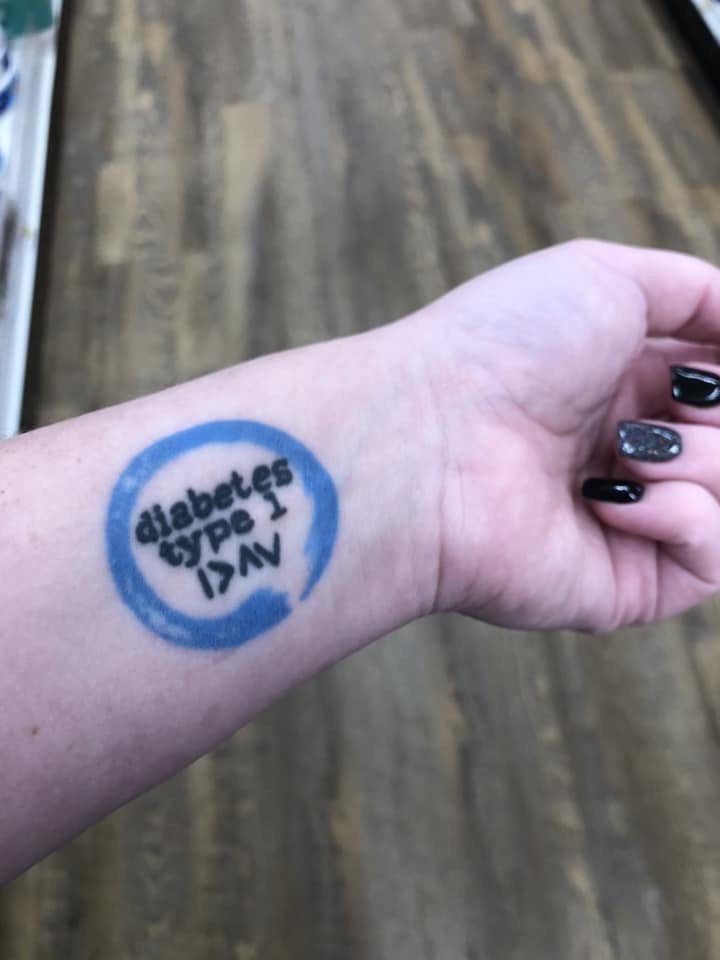
Medical alert diabetes tattoo
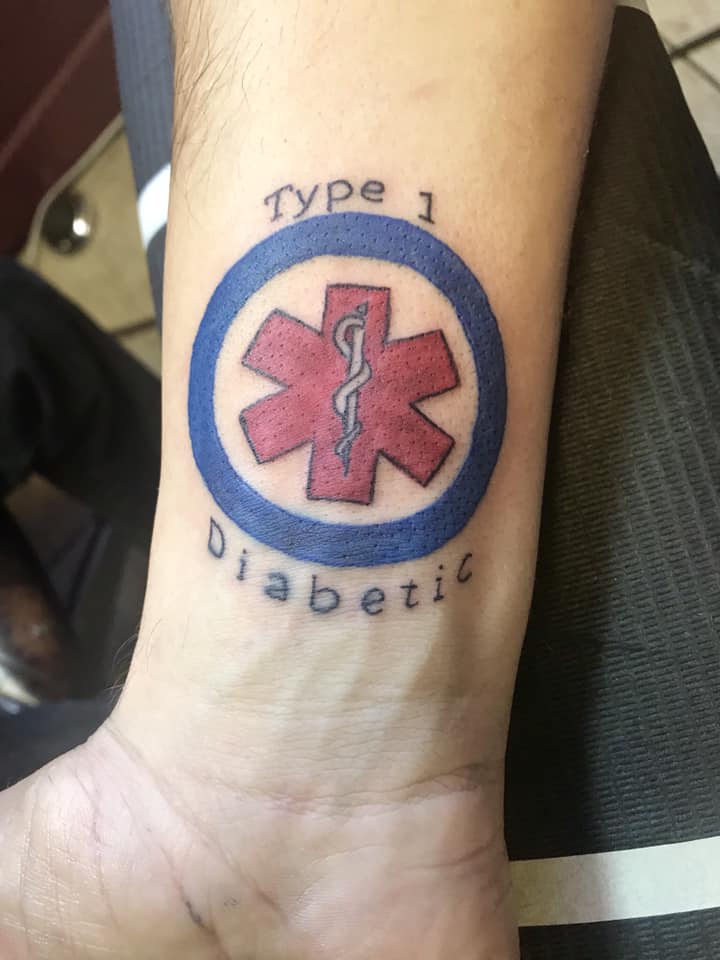
Type 1 diabetes tattoo

Insulin-dependent tattoo
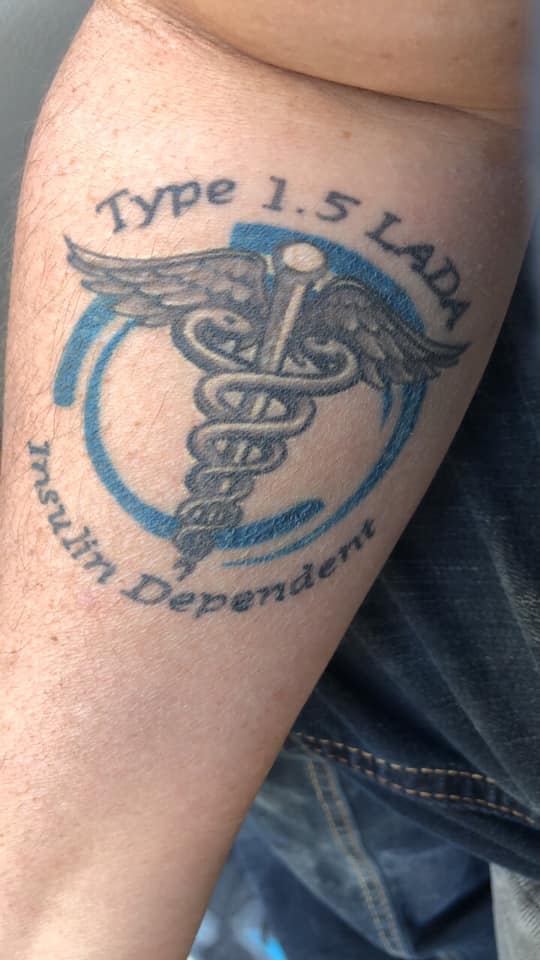
Artistic diabetes tattoo

T1 Diabetic tattoo
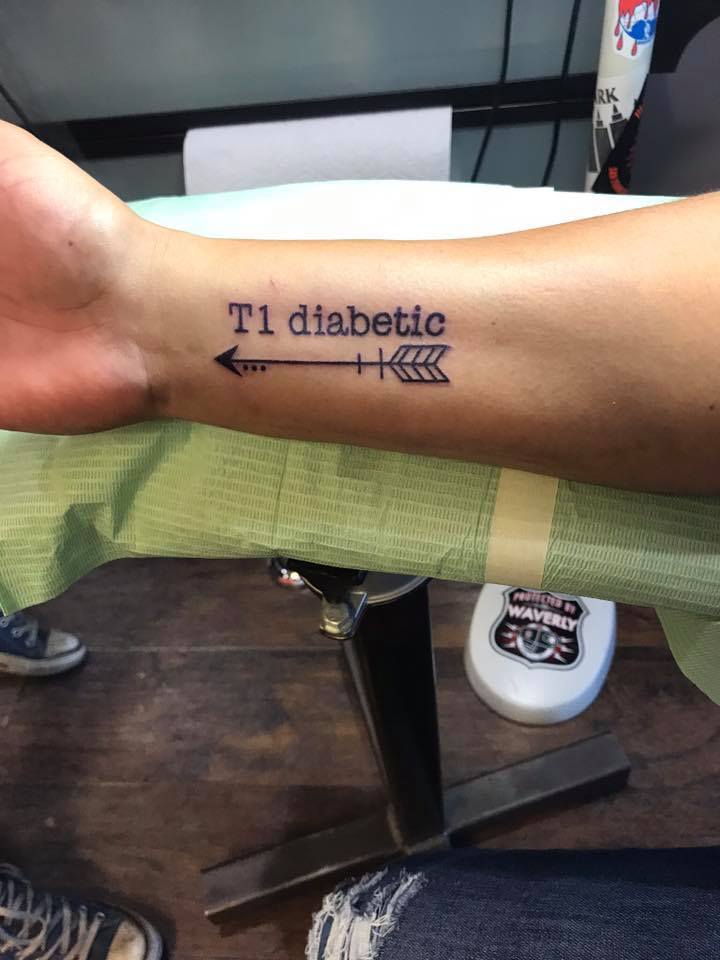
Blue circle diabetes tattoo


